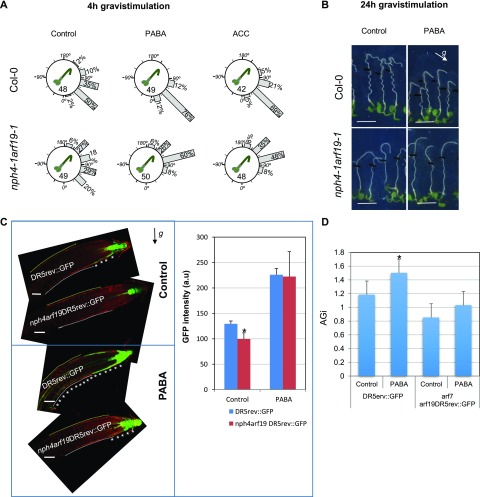Figure 6.
ARF7 and ARF19 are required for PABA-promoted root gravitropism. A and B, Seedlings were grown for 5 d on control medium and transferred to control medium supplemented or not with 200 µm PABA or 0.5 µm ACC for 24 h, then gravistimulated by rotating the plate at 135° for 4 or 24 h. A, Quantification of the root graviresponse after 4 h of gravistimulation. B, Root curvature after 24 h of gravistimulation. The black marks indicate the positions of the root apex after plant transfer. The white arrow indicates the direction of the gravity vector (g). C, Left, auxin response in wild-type (DR5rev::GFP) and in arf7arf19 (nph4-1arf19-1DR5rev::GFP) seedlings grown and gravistimulated by rotating the plate at 135° for 4 h as in A. White stars indicate the presence of the GFP signal in the LRC and/or TZ-EZ cells. Note the absence of DR5 signal in LRC cells of the control arf7arf19 root or in TZ-EZ cells of both control and PABA-treated roots. The black arrow indicates the direction of the gravity vector (g). Right, quantification of the GFP intensity of plants grown and gravistimulated as in C. a.u., Arbitrary units. D, Determination of the root AGi of plants shown in C. The data in C (right) and D are shown as means ± se (n = 15). Roots in C were stained with the plasma membrane marker FM4-64 (red). Black stars indicate significantly different GFP signal intensities between DR5rev::GFP and nph4-1arf19-1DR5rev::GFP roots (Student’s t test, P < 0.05). Bars = 1 cm (B) and 100 µm (C).

